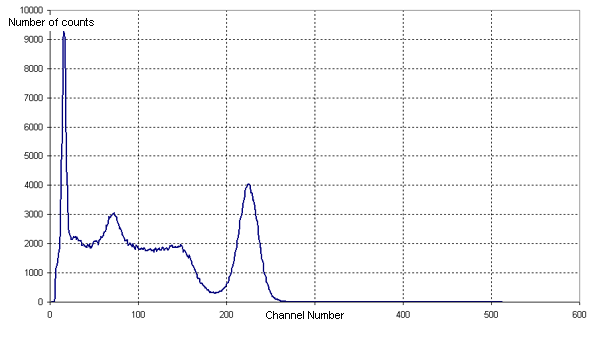Multichannel Analyzer on:
[Wikipedia]
[Google]
[Amazon]
 A multichannel analyzer (MCA) is an instrument used in laboratory and field applications to analyze an input signal consisting of voltage pulses. MCAs are used extensively in digitizing various spectroscopy measurements, especially those related to
A multichannel analyzer (MCA) is an instrument used in laboratory and field applications to analyze an input signal consisting of voltage pulses. MCAs are used extensively in digitizing various spectroscopy measurements, especially those related to
nuclear physics
Nuclear physics is the field of physics that studies atomic nuclei and their constituents and interactions, in addition to the study of other forms of nuclear matter.
Nuclear physics should not be confused with atomic physics, which studies the ...
, including various types of spectroscopy (alpha-, beta-, and gamma spectroscopy
Gamma-ray spectroscopy is the quantitative study of the energy spectra of gamma-ray sources, such as in the nuclear industry, geochemical investigation, and astrophysics.
Most radioactive sources produce gamma rays, which are of various energie ...
).
Operation
file:Gamma Pulse-Height Analyzer Principal.png, 400px, Pulse-Height Analyzer Principle: Three pulses, ''1'', ''2'', and ''3'' are detected at different times ''t''. Two discriminators emit a counting signal if their set voltage threshold is exceeded by a pulse. Pulse ''2'' triggers the ''Lower Level'' EL but not the ''Upper Level'' EU. Pulse 2 is thus counted into the spectral region denoted as ''P''. To ensure pulses are only counted into one channel, the anti-coincidence counter prevents Pulse 1 from being recorded into ''P.''A multichannel analyzer uses a fast Analog-to-digital converter, ADC to record incoming pulses and stores information about pulses in one of two ways:Pulse-height analysis
In pulse-height analysis (PHA) mode, incoming pulses are characterized based on their amplitude (peak voltage). The output spectrum is a histogram of these pulses, where the height of each channel corresponds to the number pulses counted within a narrow range of amplitudes. The resolution of the output spectrum depends on the number of channels of the MCA, which is on the order of a few thousand for typical instruments. In alpha-, beta-, andgamma spectroscopy
Gamma-ray spectroscopy is the quantitative study of the energy spectra of gamma-ray sources, such as in the nuclear industry, geochemical investigation, and astrophysics.
Most radioactive sources produce gamma rays, which are of various energie ...
, PHA is used to measure the energy distribution of particles emitted in nuclear decay. Incoming particles are absorbed by a detector medium and excite voltage pulses whose amplitudes are proportional to their energy. After many pulses have been counted, the output spectrum shows the energy distribution of the radiation incident on the detector.
Multichannel scaling mode
In multichannel scaling (MCS) mode, the MCA records a pulse count-rate over time. Unlike PHA, MCS does not differentiate pulses of different amplitudes. Instead, the MCA records all measured counts in one channel for a set time interval (called the "dwell time"), then switches to the next channel to record the subsequent time interval, and so on. The internal control voltage signal used to switch channels when the dwell time elapses is often available to the experimenter and can be used to trigger changes in the experimental setup. In this arrangement, the MCA acts as an X–Y recorder, observing changes in the count rate as a function of the controlled experimental parameter. For example, aGeiger counter
A Geiger counter (also known as a Geiger–Müller counter) is an electronic instrument used for detecting and measuring ionizing radiation. It is widely used in applications such as radiation dosimetry, radiological protection, experimental ...
connected to an MCA in MCS mode could be used to record the amount of ionizing radiation emitted by a neutron generator
Neutron generators are neutron source devices which contain compact linear particle accelerators and that produce neutrons by fusing isotopes of hydrogen together. The fusion reactions take place in these devices by accelerating either deuter ...
at different voltages.
Output Interface
Once a histogram has been recorded, the data is sent to a computer, displayed on a screen on the MCA, or (in older models) sent directly to a printer. Modern MCAs typically interface with a computer viaUSB
Universal Serial Bus (USB) is an industry standard that establishes specifications for cables, connectors and protocols for connection, communication and power supply ( interfacing) between computers, peripherals and other computers. A broa ...
or Ethernet
Ethernet () is a family of wired computer networking technologies commonly used in local area networks (LAN), metropolitan area networks (MAN) and wide area networks (WAN). It was commercially introduced in 1980 and first standardized in ...
, but some older or specialty models use RS-232
In telecommunications, RS-232 or Recommended Standard 232 is a standard originally introduced in 1960 for serial communication transmission of data. It formally defines signals connecting between a ''DTE'' ('' data terminal equipment'') suc ...
or PCI
PCI may refer to:
Business and economics
* Payment card industry, businesses associated with debit, credit, and other payment cards
** Payment Card Industry Data Security Standard, a set of security requirements for credit card processors
* Prov ...
.
See also
*Geiger counter
A Geiger counter (also known as a Geiger–Müller counter) is an electronic instrument used for detecting and measuring ionizing radiation. It is widely used in applications such as radiation dosimetry, radiological protection, experimental ...
* Oscilloscope
References
Radioactivity Laboratory equipment {{nuclear-stub